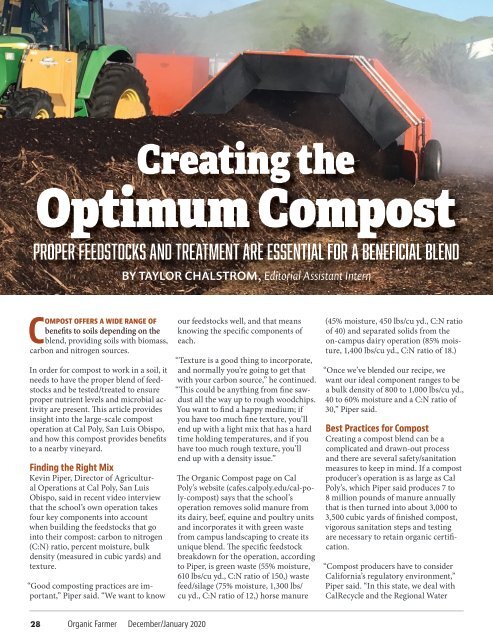OF Dec Jan 2020
You also want an ePaper? Increase the reach of your titles
YUMPU automatically turns print PDFs into web optimized ePapers that Google loves.
Creating the<br />
Optimum Compost<br />
Proper Feedstocks and Treatment Are Essential for a Beneficial Blend<br />
BY TAYLOR CHALSTROM, Editorial Assistant Intern<br />
Compost offers a wide range of<br />
benefits to soils depending on the<br />
blend, providing soils with biomass,<br />
carbon and nitrogen sources.<br />
In order for compost to work in a soil, it<br />
needs to have the proper blend of feedstocks<br />
and be tested/treated to ensure<br />
proper nutrient levels and microbial activity<br />
are present. This article provides<br />
insight into the large-scale compost<br />
operation at Cal Poly, San Luis Obispo,<br />
and how this compost provides benefits<br />
to a nearby vineyard.<br />
Finding the Right Mix<br />
Kevin Piper, Director of Agricultural<br />
Operations at Cal Poly, San Luis<br />
Obispo, said in recent video interview<br />
that the school’s own operation takes<br />
four key components into account<br />
when building the feedstocks that go<br />
into their compost: carbon to nitrogen<br />
(C:N) ratio, percent moisture, bulk<br />
density (measured in cubic yards) and<br />
texture.<br />
“Good composting practices are important,”<br />
Piper said. “We want to know<br />
our feedstocks well, and that means<br />
knowing the specific components of<br />
each.<br />
“Texture is a good thing to incorporate,<br />
and normally you’re going to get that<br />
with your carbon source,” he continued.<br />
“This could be anything from fine sawdust<br />
all the way up to rough woodchips.<br />
You want to find a happy medium; if<br />
you have too much fine texture, you’ll<br />
end up with a light mix that has a hard<br />
time holding temperatures, and if you<br />
have too much rough texture, you’ll<br />
end up with a density issue.”<br />
The Organic Compost page on Cal<br />
Poly’s website (cafes.calpoly.edu/cal-poly-compost)<br />
says that the school’s<br />
operation removes solid manure from<br />
its dairy, beef, equine and poultry units<br />
and incorporates it with green waste<br />
from campus landscaping to create its<br />
unique blend. The specific feedstock<br />
breakdown for the operation, according<br />
to Piper, is green waste (55% moisture,<br />
610 lbs/cu yd., C:N ratio of 150,) waste<br />
feed/silage (75% moisture, 1,300 lbs/<br />
cu yd., C:N ratio of 12,) horse manure<br />
(45% moisture, 450 lbs/cu yd., C:N ratio<br />
of 40) and separated solids from the<br />
on-campus dairy operation (85% moisture,<br />
1,400 lbs/cu yd., C:N ratio of 18.)<br />
“Once we’ve blended our recipe, we<br />
want our ideal component ranges to be<br />
a bulk density of 800 to 1,000 lbs/cu yd.,<br />
40 to 60% moisture and a C:N ratio of<br />
30,” Piper said.<br />
Best Practices for Compost<br />
Creating a compost blend can be a<br />
complicated and drawn-out process<br />
and there are several safety/sanitation<br />
measures to keep in mind. If a compost<br />
producer’s operation is as large as Cal<br />
Poly’s, which Piper said produces 7 to<br />
8 million pounds of manure annually<br />
that is then turned into about 3,000 to<br />
3,500 cubic yards of finished compost,<br />
vigorous sanitation steps and testing<br />
are necessary to retain organic certification.<br />
“Compost producers have to consider<br />
California’s regulatory environment,”<br />
Piper said. “In this state, we deal with<br />
CalRecycle and the Regional Water<br />
28 Organic Farmer <strong>Dec</strong>ember/<strong>Jan</strong>uary <strong>2020</strong>


















